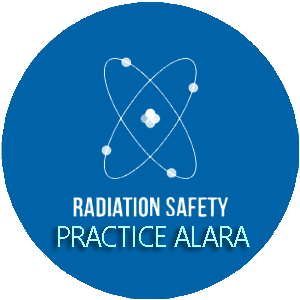
Recently interest radiopharmaceuticals used in nuclear medicine is significantly increased. However the radioactivity characteristic of this kind of medicines, should always be kept in mind. For this purpose doctors, technicians and all personals working in nuclear medicine site, should follow the ALARA principles when used of radiopharmaceuticals. Optimization of radiation protection began soon after the discovery of X-rays. The optimization-concept has been refined more and more as a result of increasing knowledge of radiation and its effect on people. The basic concept expressed in the ALARA principle can be traced back at least as far as the Manhattan Project1. The concept has been refined over the years, and the wording used to express it has changed. In 1954, the National Committee on Radiation Protection (the precursor to today’s National Council on Radiation Protection and Measurements (NCRP)) stated in Report 17 that radiation exposure should be kept “at the lowest practical level.” Similar wording (“as low as possible”) was used in the 1954 Recommendations of the International Commission on Radiological Protection (ICRP). That ICRP document also noted, with regard to protection of patients, that “the radiation exposure of the patient should be reduced as much as is compatible with successful diagnostic investigation or therapeutic treatment.” In 1959 in Publication 1, the ICRP recommended “all doses be kept as low as practicable, and that any unnecessary exposure be avoided.” ICRP further refined the principle in 1965, in Publication 9, as “all doses be kept as low as readily achievable, economic and social considerations being taken into account”. Modified language was used in 1973 in Publication 22: “as low as reasonably achievable, economic and social considerations being taken into account.” (Publication 22 was devoted entirely to explaining what the Commission intended by this recommendation.) The wording in use today was adopted in 1977 in Publication 26: “as low as reasonably achievable, economic and social factors being taken into account.” Since 1973 the acronym ALARA has been used to designate the optimization of X-ray doses. ALARA is an acronym used in radiation safety for “As Low As Reasonably Achievable.” The ALARA radiation safety principle is based on the minimization of radiation doses and limiting the release of radioactive materials into the environment by employing all “reasonable methods.” ALARA is not only a sound radiation safety principle, but it is a regulatory requirement for all “radiation protection programs.” The ALARA concept is an integral part of all activities that involve the use of radiation or radioactive materials and can help prevent unnecessary exposure as well as overexposure. The three major principles to assist with maintaining doses “As Low As Reasonably Achievable” are time, distance and shielding. “Time” simply refers to the amount of time you spend near a radioactive source. Minimize your time near a radioactive source to only what it takes to get the job done. If you are in an area where radiation levels are elevated, complete your work as quickly as possible, and then leave the area. There is no reason to spend more time around it than necessary. “Distance” refers to how close you are to a radioactive source. Maximize your distance from a radioactive source as much as you can. This is an easy way to protect yourself because distance and dose are inversely related. If you increase your distance, you decrease your dose. To shield yourself from a radiation source, you need to put something between you and the radiation source. The most effective shielding will depend on what kind of radiation the source is emitting. Some radionuclides emit more than one kind of radiation. Low-level radioactive sources such as those in smoke detectors, radiopharmaceuticals (used in nuclear medicine) and isotopes used in research may be used to cause fear and panic. No immediate health effects would be expected and the probability of any long-term effects would be very low. Highly radioactive sources such as cobalt-60, caesium-137 (used in radiotherapy machines) and iridium-192 (used in industrial radiographic devices) can cause serious exposure. However, sources are usually metallic and easily detectable at check-points. Serious exposure would probably involve those who have handled the sources or those with local radiation-induced skin injuries, who are at risk for acute radiation syndrome requiring medical attention. IAEA-recommended absorbed dose limits for radiological workers and members of the public. References 1. Radiation accidents and their management: emphasis on the role of nuclear medicine professionals. Bomanji JB1, Novruzov F, Vinjamuri S. 2. The ALARA principle in medical imaging. Doland L.Miller, David Schauer By Shukurov R.
If this page is in your subscriptions, then it will be removed. You will not see this page. If you want to unblock a user, go to the settings, the list of blocked users and click unblock